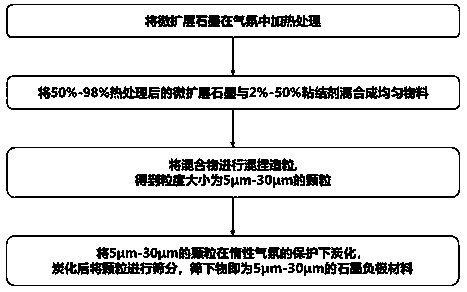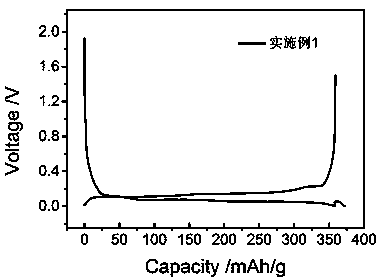Preparation method of graphite anode material
A graphite anode, natural graphite technology, applied in battery electrodes, electrical components, electrochemical generators, etc., can solve the problems of reduced vibration, rough surface morphology of graphite, unfavorable anode slurry processing, etc., to improve dynamic performance , Solve the effect of rough surface morphology, which is conducive to uniform bonding
- Summary
- Abstract
- Description
- Claims
- Application Information
AI Technical Summary
Problems solved by technology
Method used
Image
Examples
Embodiment 1
[0030] Such as figure 1 As shown, the micro-expanded natural graphite with an average particle size of 5 μm and a volume expansion multiple of 2 times was placed in a tube furnace, and the temperature was raised to 200 °C at 3 °C / min in an air atmosphere, and the temperature was kept constant for 3 hours. After cooling, mix VC with coal tar pitch to form a uniform material. The mass ratio of coal tar pitch in the mixture is 40%. Add the mixture to the stirring / heating device, the heating temperature is 300°C-650°C, and the constant temperature time is 2-8 hours. Then the cooled sample was placed in a carbonization furnace filled with nitrogen atmosphere for carbonization, the temperature was raised to 800°C at 3°C / min, and the temperature was kept constant for 3h. After carbonization, the particles are sieved, and the undersieve is the graphite negative electrode material with a diameter of 10.8 μm.
[0031] The same method as the comparative example was used to prepare the ...
Embodiment 2
[0033] Micro-expanded natural graphite with an average particle size of 10.1 μm and a volume expansion multiple of 1.5 times was placed in a tube furnace, and in an air atmosphere, the temperature was raised to 600 °C at 2 °C / min and kept at a constant temperature for 3 hours. After cooling, mix VC with petroleum asphalt to form a uniform material, and the mass ratio of coal tar pitch in the mixture is 10%. Add the mixture to the stirring / heating device, the heating temperature is 300°C-650°C, and the constant temperature time is 2-8 hours. Then the cooled sample was placed in a carbonization furnace filled with helium atmosphere for carbonization, the temperature was raised to 950°C at 2°C / min, and the temperature was kept constant for 3h. After carbonization, the particles were sieved, and the undersieve was the graphite negative electrode material with a diameter of 17.6 μm.
[0034] The button battery was prepared by the same method as the comparative example for electroc...
Embodiment 3
[0036]Micro-expanded natural graphite with an average particle size of 8.0 μm and a volume expansion multiple of 1.5 times was placed in a tube furnace, and the temperature was raised to 1000 °C at 5 °C / min under a nitrogen atmosphere, and the temperature was kept constant for 3 hours. After cooling, carry out Y-shape mixing with phenolic resin to form a homogeneous material, and the mass ratio of phenolic resin in the mixture is 15%. Add the mixture to the stirring / heating device, the heating temperature is 300°C-650°C, and the constant temperature time is 2-8 hours. Then the cooled sample was placed in a carbonization furnace filled with argon atmosphere for carbonization, and the temperature was raised to 1200°C at 5°C / min, and the temperature was kept constant for 4h. After carbonization, the particles are sieved, and the undersieve is the graphite negative electrode material with a diameter of 10.5 μm.
[0037] The same method as the comparative example was used to prepa...
PUM
| Property | Measurement | Unit |
|---|---|---|
| Granularity | aaaaa | aaaaa |
| The average particle size | aaaaa | aaaaa |
Abstract
Description
Claims
Application Information
 Login to View More
Login to View More - R&D
- Intellectual Property
- Life Sciences
- Materials
- Tech Scout
- Unparalleled Data Quality
- Higher Quality Content
- 60% Fewer Hallucinations
Browse by: Latest US Patents, China's latest patents, Technical Efficacy Thesaurus, Application Domain, Technology Topic, Popular Technical Reports.
© 2025 PatSnap. All rights reserved.Legal|Privacy policy|Modern Slavery Act Transparency Statement|Sitemap|About US| Contact US: help@patsnap.com



